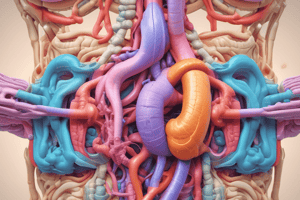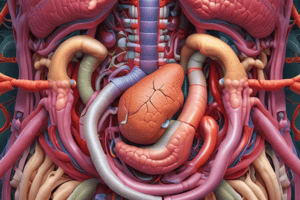Podcast
Questions and Answers
What is the primary function of the digestive system?
What is the primary function of the digestive system?
- To produce hormones for maintaining homeostasis
- To eliminate waste products from the body
- To regulate body temperature
- To provide nutrients for cell maintenance and growth (correct)
Which of the following is NOT an accessory digestive organ?
Which of the following is NOT an accessory digestive organ?
- Liver
- Pancreas
- Small intestine (correct)
- Gallbladder
What is the process that involves muscular movement of the digestive tract to physically break down food into smaller particles?
What is the process that involves muscular movement of the digestive tract to physically break down food into smaller particles?
- Propulsion
- Segmentation
- Absorption
- Mechanical digestion (correct)
What is the term for the involuntary, alternating waves of contraction and relaxation of muscles in the organ walls?
What is the term for the involuntary, alternating waves of contraction and relaxation of muscles in the organ walls?
Which activity of the digestive system involves the oral cavity allowing food to enter the digestive tract and mastication (chewing) of food?
Which activity of the digestive system involves the oral cavity allowing food to enter the digestive tract and mastication (chewing) of food?
What is the primary function of the muscularis externa in the alimentary canal?
What is the primary function of the muscularis externa in the alimentary canal?
Which of the following is NOT a function of the mucosa in the alimentary canal?
Which of the following is NOT a function of the mucosa in the alimentary canal?
What is the main function of the submucosa in the alimentary canal?
What is the main function of the submucosa in the alimentary canal?
What is the role of myenteric plexus in the alimentary canal?
What is the role of myenteric plexus in the alimentary canal?
Which layer of the alimentary canal contains Meissner’s plexus?
Which layer of the alimentary canal contains Meissner’s plexus?
______ digestion involves hydrolysis reactions aided by enzymes to chemically break down food particles into nutrient molecules
______ digestion involves hydrolysis reactions aided by enzymes to chemically break down food particles into nutrient molecules
Carbohydrates are broken down into ______
Carbohydrates are broken down into ______
Proteins are broken down into ______
Proteins are broken down into ______
Fats are broken down into glycerol and ______
Fats are broken down into glycerol and ______
The digestive system provides nutrients for cell maintenance and growth. The GIT can be organised into: 1. Alimentary canal (Digestive tract) (mouth, pharynx, oesophagus, stomach, small intestine and large intestine, rectum, and anal canal). 2. Accessory digestive organs (Teeth, tongue, salivary glands, the liver, the gallbladder and the pancreas). The activities of the digestive system The activity of the digestive system can be categorised into 5 processes: 1. _______ 2. Propulsion 3. Digestion 4. Secretion 5. Absorption 6. Defecation
The digestive system provides nutrients for cell maintenance and growth. The GIT can be organised into: 1. Alimentary canal (Digestive tract) (mouth, pharynx, oesophagus, stomach, small intestine and large intestine, rectum, and anal canal). 2. Accessory digestive organs (Teeth, tongue, salivary glands, the liver, the gallbladder and the pancreas). The activities of the digestive system The activity of the digestive system can be categorised into 5 processes: 1. _______ 2. Propulsion 3. Digestion 4. Secretion 5. Absorption 6. Defecation
The uptake of nutrient molecules into the epithelial cells of the digestive tract and then into the blood or lymph is known as ______
The uptake of nutrient molecules into the epithelial cells of the digestive tract and then into the blood or lymph is known as ______
The activity of the digestive system can be categorised into 5 processes: 1. Ingestion 2. _______ 3. Digestion 4. Secretion 5. Absorption 6. Defecation
The activity of the digestive system can be categorised into 5 processes: 1. Ingestion 2. _______ 3. Digestion 4. Secretion 5. Absorption 6. Defecation
The activity of the digestive system can be categorised into 5 processes: 1. Ingestion 2. Propulsion 3. _______ 4. Secretion 5. Absorption 6. Defecation
The activity of the digestive system can be categorised into 5 processes: 1. Ingestion 2. Propulsion 3. _______ 4. Secretion 5. Absorption 6. Defecation
The activity of the digestive system can be categorised into 5 processes: 1. Ingestion 2. Propulsion 3. Digestion 4. _______ 5. Absorption 6. Defecation
The activity of the digestive system can be categorised into 5 processes: 1. Ingestion 2. Propulsion 3. Digestion 4. _______ 5. Absorption 6. Defecation
The activity of the digestive system can be categorised into 5 processes: 1. Ingestion 2. Propulsion 3. Digestion 4. Secretion 5. _______ 6. Defecation
The activity of the digestive system can be categorised into 5 processes: 1. Ingestion 2. Propulsion 3. Digestion 4. Secretion 5. _______ 6. Defecation
Flashcards are hidden until you start studying




